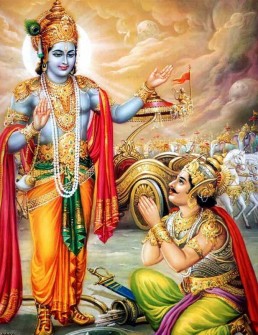The same black-board is approached by different teachers to explain different subjects, during a single day in a class room. The mathematics teacher’s geometrical figures and calculations are wiped clean by the geography teacher to design his maps of the world and to trace the path of rivers, the location of lakes and the position of mountains. When the chemistry teacher arrives, he erases the entire world of mountains, rivers and oceans represented on the black-board, and he, in his turn, writes on it the laws of chemical reactions among the various elements and their compounds. The history teacher makes the black-board clean again, to scribble on it the ancestral trees of dynasties destroyed and families forgotten. Each teacher comes and writes on the black-board different words and symbols which represent the design of knowledge that he has in his bosom. But all designs were chalked out and executed upon the same black-board, which illumined the mathematical calculations, the geographical data, the chemical formulae, and the historical facts, in turn.
Similarly, the changing world of the unmanifest must have one Changeless Substratum, “THAT WHICH IS NOT DESTROYED BY THE DESTRUCTION OF ALL BEINGS (bhutas).” When, in the evening, the students and teachers have all left the class room, the black-board still remains. The principle of Pure Consciousness, Itself Unmanifest — inasmuch as It is not perceivable by the sense organs or comprehensible by the mind and intellect — is indicated here as the changeless substratum of all, when the Lord declares, “BEYOND THIS UNMANIFEST, THERE IS THE OTHER ETERNAL EXISTENCE, THE UNMANIFESTED.”
The unmanifest (vasanas) are the seeds of the manifest and they constitute, what Vedanta indicates by its very familiar term, “Ignorance” (Avidya). “Ignorance” can be only of an existent something; I cannot be ignorant of my tail, since I do not have a tail. This proves the existence of some Positive Factor called the Truth, the Self — the black-board upon which all other conditional knowledges are scribbled — serving as the Permanent and Changeless Substratum. “The ignorance of the Real Nature of this Eternal Factor,” is called Avidya, which, in its turn projects the manifested ever-changing world of names and forms. The Ultimate Reality, the Self, is being indicated here as something that lies beyond the hazy frontiers of the delusory experiences of creation, dissolution, and re-creation, over and over again.
IS THIS UNMANIFEST THEN THE SUPREME? OR, IS THERE YET ANOTHER FACTOR WHICH ALONE IS FIT TO BE THE GOAL OF LIFE?

